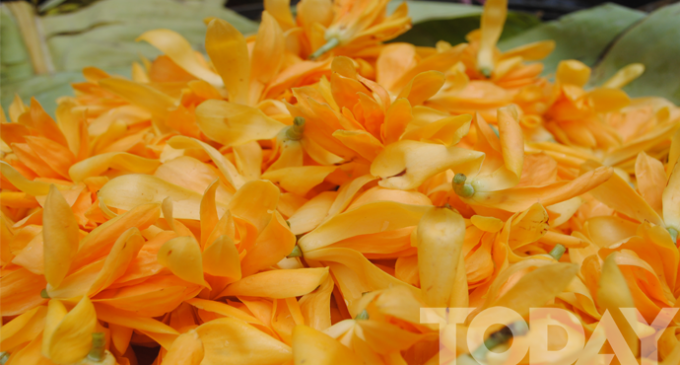FLORA IN MYANMAR CULTURE SAGAWA FLOWER IN KASONE

Kasone, the second month of Myanmar Lunar calendar corresponds to May, warmest the month of Myanmar summer. Myanmar old saying goes ]]wefcl;a&ukef? uqkefa&cef;}} [In Tayu water diminishes, in Kasone, water dries up] (uqkef? e,kef? aqGY aqGYckef) [In Kasone and Nayone the heat is unbearable].
Sacred month for the Buddhists because it was on the fullmoon day of this month in the Maha Sakarit year [Buddha Era] of 103 that the Bodisatta became enlightened and attained Buddhahood under the shade of Maha Bodhi Tree [Ficus Religiosa]. Even hard tree like Bannyan need water as direct rays of scorching sun dries up all water from earth. Therefore the festival of this month is pouring water on the sacred Bodhi Tree and removing watery creatures to lakes and rivers with plenty of water as an act of life saving charity.
Among many flowers that bloom in this season, Sagawa [Chapa Michelin] is traditi-onally designated as flower of this month. Champac is also a Bodhi Tree because the 19th Buddha of the 28 previous Buddhas “Siddhathta” was enlightened under the shade of champac Tree.
Champac is a timber tree that grows wild in any part of the country. But its original habitat is Mt. Popa area near Bagan. It grows up to the height of a teak tree and its width is also equal to that of teak. Its gorgeous flowers [gold yellow or pale white] spring from a close relative of the Magnolia family, whose scientific name champac is a derivative of Pali word “Sampaka”. Native to India and South East Asian peninsula, it produces a camphor-like substance and oil used in perfume. It is an essential ingredient in Ayuveda medicine because of its medicinal pro-perties. Gold yellow “Sagawa” and pale white “Saga Phyu” are used in aromatherapy for refreshing, relaxing and stress reduction. They are soaked in ointment to produce hair tonic.
At Ananda Temple in old Bagan, one can still see a tall standing Buddha Image of 31 feet high carved out of a single Sagawa Tree, donated by King Kyanzittha in 1091 AD Today in 2014 this Image is 923 years old.
Sagawa flower has two famous legends behind it. The first legend goes that at Tagaung Kingdom to the north east of Bagan there lived a mighty black smith named Maung Tint Dei who could produce many objects of good quality domestic utensils, agricultural tools and war weapons. The King was afraid that he would rebel against him with his followers and weapons. The King sent his men to arrest him who fled in hiding. The king raised his beautiful sister to one of his queens and told her that he would appoint his brother-in-law as interior knight-minister. The sister sent this message to her brother. When Maung Tint Dei appeared at the court the King did appoint him to that post. But later he arrested him and tied him to the trunk of a big champac tree and burnt him alive. On hearing this horrible news, the sister came out and jumped into the fire. In vain, the King tried to rescure her by pulling her hair knot. But the entire body was burnt with her brother. The king gilt her head as Shwe Myat Hnar [Gold Face]. Because of their violent death the two siblings became nat spirits dwelling in that Tree and molesting any creature that came under its shade. The King ordered his men to uproot and float down the tree in the Ayeyawady River.
When the tree stranded at the Jetty of Bagan, the then King Thayligyaung [344-387 AD] had a dream in which the two nat siblings appeared to relate their tragedies, requesting the king to give them a place to rest and reside and promised him that they would protect his city from all enemies and dangers. The cham-pac tree recovered at the jetty was cut into two, the taller half representing the brother and the other half the sister and placed them on the summit of main Mt. Popa hill range under a big shrine. The king ordered the local people to hold yearly homage festival to them in the cold month of Nat taw (December). Two shrines were built on either side of the entrance gate Tharapa of his Bagan City in which the Image of the brother on the right and that of the sister on the left were made to receive yearly homage paying festival. They were given royal titles Eindwin Min Maha Giri (Great royal nat spirits on the great Mountain, who look after every household). People were required to keep a green coconut fruit hung on the pole of their house, with flowers, scents and other decora-tions to give a cold rest place for the two siblings who died of fire burn. These two nats rank highest among in the 37 nat spirits of Myanmar Pantheon.
Another legend is that of Byatta, a speedy equestrian knight of King Anawrahta (1044-1077 AD) Who was assigned to gather fresh flowers (champac) three times a day for royal use. He fell in love with a local flower gatherer Mei Wunna (believed to be a flower eater ogress). They had two sons Shwe Hpyin Gyi and Shwe Hpyin Ngwe. When the king found out their secret love affair he was very angry and put Byatta to death, and captured their two sons for adoption as his grandsons at the court. Mei Wunna died of broken heart over the loss of husband and the two sons. Byatta and Mei Wunna became nat spirits still dwelling on Mount Popa Range. They also received yearly homage festival held by the believers in the month of Nattaw.
 In Myanamr visual, performing and literary arts the beauty and colour complexions of Tint Dei’s sister and Mei Wunn, are likened to the beauty and colour of champac flower.
In Myanamr visual, performing and literary arts the beauty and colour complexions of Tint Dei’s sister and Mei Wunn, are likened to the beauty and colour of champac flower.
The following is an Ode to Mt Popa by an unknown poet of old Bagan time. Tint Dei’s sister Myat Hla was metapharically named Champac Flower.”
A Ode to sacred Mt. Popa
1. Oh Nat Spirit with floral crowns!
On lofty Mt papa Range sublime
Thickets of champac flowers so divine
Their yellow hue, mistaken for gold flowers,
Ladening their entwinning bowers
2. Oh nat spirits with floral crowns!
Likened me to champac flowers
Daughter of a brave warrior.
Fair cousin of my brother elder
Who is an a journey so far.
3. Oh Nat Spirits with floral crowns!
My darling in my caress
wearing red towel around his head.
And lenine white cotton jacket.
A knight designate, yet a manly swain
I’ve tried his love to gain.
4. Oh Nat Spirits with floral crowns!
Since I wore Myeik Lut Su hair knot
Of a teenager, we each other
Kept in thoughts
He’s a nephew of my father
He’s my most beloved lover
Till the end of our lives
We faithfully keep our troth plight.
ပုပၸားနတ္ေတာင္လကၤာ
၁။ သိုးကေလ၊ ပုပၸားနတ္ေတာင္
အေခါင္ျမင့္ဖ်ား၊ စံုေတာျပား၌
နံ႔ရွားႀကိဳင္လြင့္၊ ခါတန္ပြင့္သည္
ေရႊႏွင့္ယိုးမွား ပန္းစကား။
၂။ သိုးကေလ၊ စကားပြင့္ႏွင့္
ႏႈိင္းတင့္ႏိုးသည္၊ ရဲမ်ဳိးသမီး
ေမာင္ႀကီးႏွမ၊ ညက္လွျပာစင္
မယ္သည္ပင္သည္၊ ခရီးသား။
၃။ သိုးကေလ၊ ေဆြမိမင္း
မ်က္သုတ္နီစင္
ရထည္းဖ်င္ႏွင့္
ႀကိဳင္းစင္ျမ၀ါ
မတ္ႀကီးလ်ာကို
မယ္သာႀကိဳက္မိ
တုမရွိ။
၄။ သုိးကေလ၊ ၿမိတ္လြတ္စုလည္း
အငယ္တည္းက၊ ကၽြမ္း၀င္ၾကသည္
ေမြးဖတူရင္း၊ မ်ဳိးသည္မင္းကို
ခ်စ္ခ်င္းစု႐ံုး
သက္ထက္ဆံုးသည္
ႏွလံုးမျခား၊ ေစာင့္တရား။
At any local stall in Mt Popa area, tradi-tionally preserved Sagawa flowers stuffed in bottles are on sale to take home as souvenir to keep your fond memories of Bagan, Mt Popa and gold champac flowers.
Sithu Dr Khin Maung Nyunt
./wp-content/uploads/2018/10/Emirate-Online-TDY.png)
















There are no comments at the moment, do you want to add one?
Write a comment